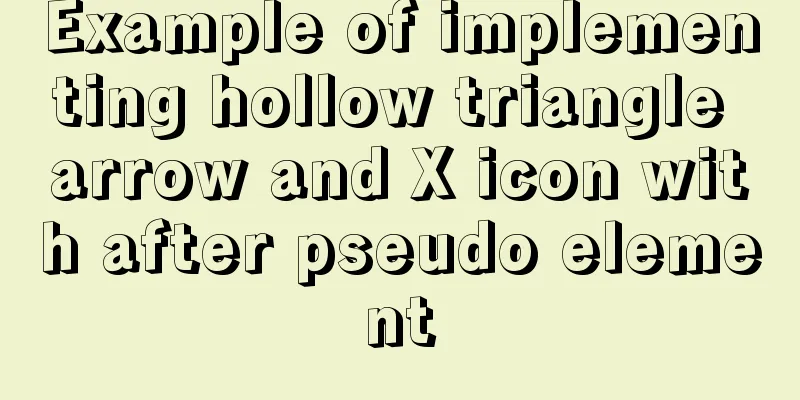Example of implementing hollow triangle arrow and X icon with after pseudo element

|
In the front-end design draft, you can often see close buttons in the shape of 'X', '>' and hollow arrow icons in three other directions. There are many ways to implement CSS. After trying it, I found that it is not easy to remember. Today I will write a simple method to implement it using the after pseudo-element. 1. Close icon
HTML part <span class="close"></span> CSS part
.close{
display: inline-block;
width: 14px;
height: 1px;
background: #95835e;
transform: rotate(45deg);
-webkit-transform: rotate(45deg);
}
.suClose:after {
content: '';
display: block;
width: 14px;
height: 1px;
background: #95835e;
transform: rotate(-90deg);
-webkit-transform: rotate(-90deg);
}The principle is to use the span element and the after pseudo-element to draw two straight lines, and use the transform attribute of CSS3 to rotate them separately to achieve the effect of intersection. 2. Hollow triangle arrow
HTML part <span class="arrowUp"></span> CSS part
.arrowUp:after {
content: '';
display: inline-block;
width: 8px;
height: 8px;
border-top: 1px solid #656565;
border-right: 1px solid #656565;
transform: rotate(-45deg);
-webkit-transform: rotate(-45deg);
}
HTML part <span class="arrowUp"></span> CSS part
.arrowUp:after {
content: '';
display: inline-block;
width: 8px;
height: 8px;
border-top: 1px solid #656565;
border-right: 1px solid #656565;
transform: rotate(45deg);
-webkit-transform: rotate(45deg);
}The principle is to use the after pseudo-element to draw a rectangle, depicting only the top and right borders, thus forming an arrow shape, and then use the transform attribute to adjust the angle to achieve different orientations. Here we give examples of two directions. For the other two directions, you only need to change the angles. This is the end of this article about the example of using the after pseudo-element to implement a hollow triangle arrow and an X icon. For more information about how to implement a hollow triangle arrow and an X icon with after, please search 123WORDPRESS.COM’s previous articles or continue browsing the following related articles. I hope you will support 123WORDPRESS.COM in the future! |
>>: Problems with nodejs + koa + typescript integration and automatic restart
Recommend
ERROR 1862 (HY000): Your password has expired. To log in you must change it using a .....
error message: ERROR 1862 (HY000): Your password ...
The difference between the knowledge of front-end developers and artists in website development
Abstract: Many companies, even most companies whos...
The latest version of MySQL 8.0.22 download and installation super detailed tutorial (Windows 64 bit)
Table of contents Preface 1. Download MySQL 8.0.2...
How to implement two-way binding function in vue.js with pure JS
Table of contents First, let's talk about the...
Setting up Docker proxy under CentOS 7 (environment variable configuration of Systemd service under Linux)
The Docker daemon uses HTTP_PROXY , HTTPS_PROXY ,...
How to use the Linux more command in Linux common commands
more is one of our most commonly used tools. The ...
MySQL scheduled task example tutorial
Preface Since MySQL 5.1.6, a very unique feature ...
Implementing password box verification information based on JavaScript
This article example shares the specific code of ...
HTML tags explained
HTML tags explained 1. HTML tags Tag: !DOCTYPE De...
Linux kernel device driver memory management notes
/********************** * Linux memory management...
Use CSS's clip-path property to display irregular graphics
clip-path CSS properties use clipping to create t...
Vue implements simple image switching effect
This article example shares the specific code of ...
Detailed deployment of Alibaba Cloud Server (graphic tutorial)
I have recently learned web development front-end...
JavaScript to achieve a simple message board case
Use Javascript to implement a message board examp...












